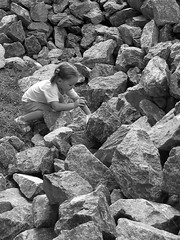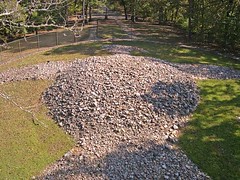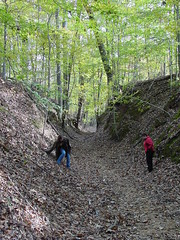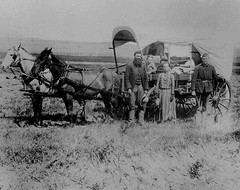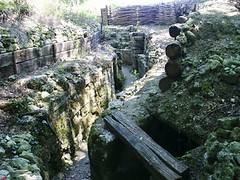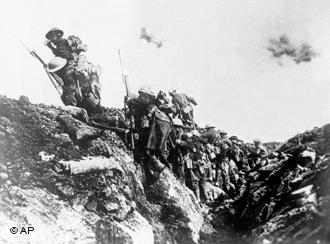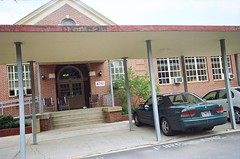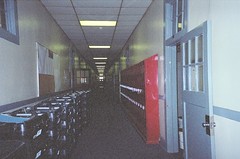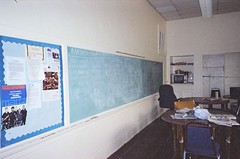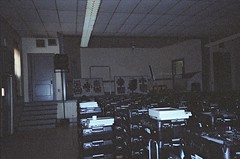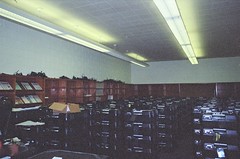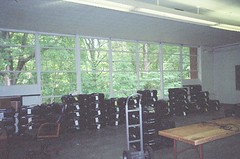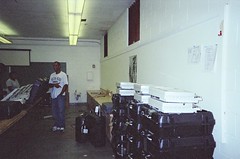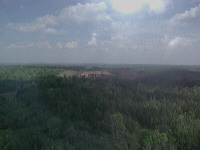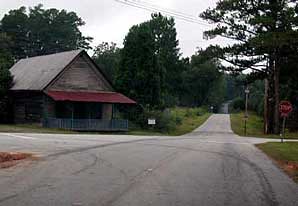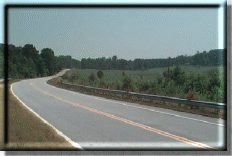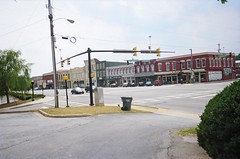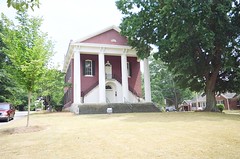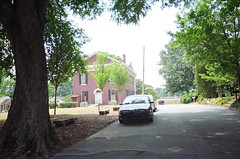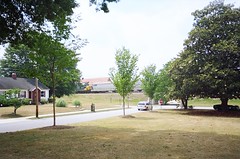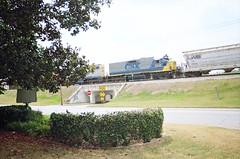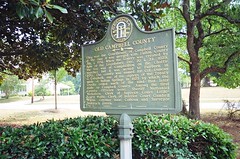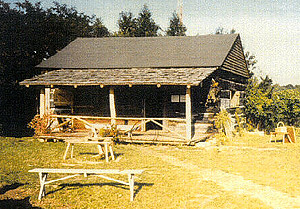
Last night I finally felt I could sit down and write about the visit I made to my old home site. I’ve thought about it for a couple of days and have written some things down in longhand….a section here and section there….ideas that fit some of the pictures I made….a note to myself regarding a thought I want to make sure I include, but this section of my scavenger hunt was difficult and I’m still trying to sort out why.
Part one of my scavenger hunt can be read here, part two here, and part three here.
The product I ended up with last night was Historians Observe Their Surroundings. At some point I had to make a choice…continue on the path of explaining my lesson on how history changes a piece of property or launch into my hunt for my childhood home. They are both linked but contained far too much material for one post so I opted for the lesson piece and once again put off facing my past. It is funny how some ideas just seem to erupt and tumble out of me while others stay locked in my brain and just churn away like the agitator on a washing machine.
The first picture you see is my dad, my sister, and I on the front steps that led up to our Red Oak home. You can barely see the large front porch that I wrote about a few days earlier here. I won’t tell you which one I am, but I’m not the one in the middle! History has changed the landscape behind us. The picture below shows the same view except it is taken approximately 300 feet further back and across the track. The raised plot of ground our house sat on is gone, the front steps where we sat is gone, the trees that gave our porch privacy are gone, and the house is gone………gone.
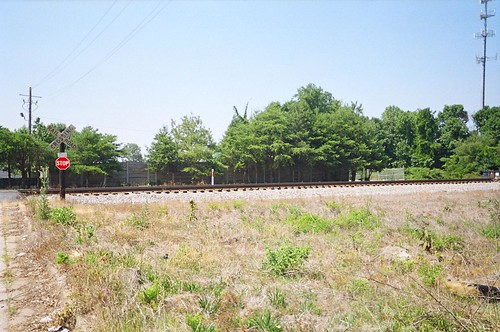
Think about the plot of land that you live on. What was there ten years ago? One hundred years ago? One thousand years ago? Ten thousand years ago? Maybe you’ve seen the more recent version of the movie The Time Machine where the main character activates the machine and you see the scenery change around him as he advances or goes back in time. It’s a really fascinating scene to me as it advances in rapid time and you see things being torn down or built up or over other things.
Think about it seriously as you move about your day…..are you walking the same steps as a wooly mammoth? Or are you sitting in the same spot a Confederate soldier lay dying? Are your children playing in a spot a young Native American child called his or her special place? Is there an old family home at the bottom of the lake you water ski on or skim across as you try to find that perfect fishing spot?
Maybe that’s what got to me this week as I visited childhood places. Things move too fast these days. During our lifetime we see many changes in the landscapes we live in. The people who inhabited the Earth before us rarely saw major changes in their lifetime or left the areas they grew up in for that matter. Many people lived and died on the same plot of land. Most of the students in my classroom have already lived in at least three places or more. Is it any wonder we have lost our attachment to our land?
As I traveled up Roosevelt Highway from Red Oak I saw the same scene I had seen as a child. Ahead of me on up the road was the green steel span of the bridge where Interstate 285 crosses the highway. We always used the bridge as a frame of reference for folks trying to find our house…..if you get to the bridge you’ve gone too far…we'd say. I reached my street which at one time was called West Point Road, but I don’t know why. It doesn’t go anywhere. Maybe at one time it actually did. In my day it crossed the track and became the drive and parking lot for the lumber yard my dad managed. It was the only way in and out of the property which caused my mom some concern through the years as she never wanted to need a fire truck or ambulance only to have a train stop on the track.
Making the right turn off Roosevelt Highway I crossed the railroad track. Once on the other side I found myself in an environment that felt so familiar yet looked so alien. Down in the very core of my soul I could feel I was in familiar territory yet nothing, nothing was as it should be. A glass recycling plant now sits on the property. Large mountains of glass bottles dot the grounds and crushed glass carpeted the asphalt.


I felt kind of silly as I walked into the office and announced who I was. The plant personnel were very kind, but unfortunately they couldn’t tell me anything. They did not buy the property from my dad’s employer after the fire. One nice man handed me a bright orange business card and said, “Call this guy, I bet he can tell you about your old house. He owned the property before us.” I said I would and then asked permission to walk the property and take some pictures. They were very nice to allow me to do that.
I walked around to the back of the plant. It was the area where the showroom had a huge warehouse with four aisles filled with all types of doors, mouldings, sheetrock, nails, etc. Customers would come around to the back where the aisle doors opened up to a very large dock where trucks and cars could be loaded up. Dad used to have large contractor dinners where he would invite all the builders in the area and their wives for steak dinners. We’d place grills on the dock and set up long tables. All the employees would stay after work and help out along with my mom, sister, and I. Dad always expected my sister and I to make nice and behave. I absolutely loved these customers….they were family….we went to church with some of them, and my sister and I went to school with their kids. Twice a year Dad would have inventory in the showroom and warehouse and even as a young girl I was assigned something to count. During annual sales Dad would set up a hot dog stand and employ my sister and I to man it. The best fun was having the whole run of the place. I used my status as the boss’ daughter to the hilt. There wasn’t a nook or cranny on that property that I didn’t know or visit daily whether on my bike or a golf cart that Dad bought for us to “play” with. On busy summer days I wound my way in and out of large delivery trucks, customer’s cars coming and going, and even obnoxiously rode my bike in the showroom saying excuse me as I edge by customers trying to choose a new bathroom sink or replacement door. I don’t think Home Depot would put up with that, but they don’t provide steak dinners to their best customers either, as far as I know.
When you visit a piece of property that has changed so drastically you look for landmarks…anything to give you that frame of reference so you can determine where past structures were. I tried, I really tried, but I couldn’t make too many determinations until I walked back out to the railroad track and looked back towards where I knew the house should be. Do you see the metal scale sticking up from the asphalt in this shot? The raised plot of ground my house sat on was somewhere right there.
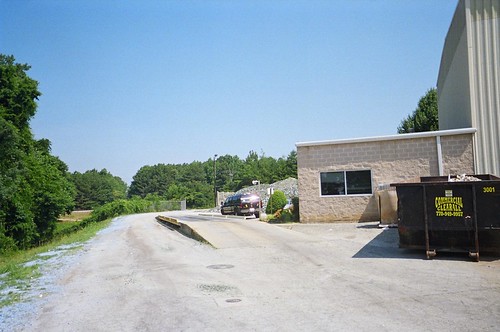
As I re-crossed the track I took this picture looking back towards Red Oak.
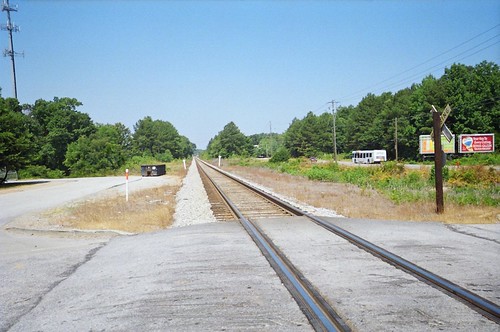
I thought about all the times I had stood on the track looking in the same direction. I thought about all the pennies we had laid on the track waiting for the train to flatten them to flitters. I thought about how at four years old I was so scared of the train that I could hear it coming from miles away. I would go tearing into the house before it could come. It was quite sometime before I would stay outside to watch the train go by, but I eventually became brave enough. I looked around at all the changes to this plot of ground I had called home for so long and as I looked down the track towards Red Oak I remembered all along the track that stretched before me Union soldiers had disrupted the lines during their march to Rough and Ready as part of Sherman’s March to the Sea. I wondered what the land looked like then. Finally I remembered how I used to balance on the rails, one foot in front of the other to see how fast and how far I could go. So, if you had been traveling down Roosevelt Highway a few days ago you would have seen a crazy, forty-something, overweight woman trying to recapture her childhood by recreating a balancing act on a train rail. Let’s just say I’m out of practice.
On the way home I pulled out the card the man had given me at the glass recycling place. If my home exists the man listed on the card may have the information I need. Unfortunately he is out of town until after the fourth of July. Guess we’ll have to wait a few more days for more definitive information.
The night I came home from walking the old property I was thoughtful about it…in fact I couldn’t stop thinking about it. I had one of those up and down kind of nights, and unfortunately hubby paid the price. I disturbed him all night long. I think he’ll be glad when my scavenger hunt is over.
As I tried over the last couple of days to write this I uploaded my pictures and got them ready to place. As I walked around the property I was really taken with all of the shards of broken glass everywhere I looked. Even though it was a devastated looking landscape compared to what I remembered the sun made all of the glass sparkle and shine, and I knew I had to snap a picture of it. I held the camera out in front of me and snapped the ground not really caring about what I snapped as long as I had a carpet of glass in the picture. Of course being the klutz that I am I managed to get my shadow in the picture so I had to crop it to cut me out of it. As I looked at my finished picture I was amazed. Do you see what I see on the lower right side? A penny! I walked that whole lot. I could have taken a picture of any spot at any time and something had me choose the spot with a penny.

I take the penny as a sign… a sign that man goes on shaping and reshaping his landscape. It’s up to us as caretakers to catalog and index how we use the land so that others who come after us can appreciate the wonderful resource that land can be. In this way all of our stories, good and bad, won’t be forgotten.

